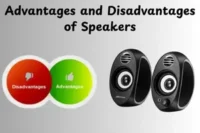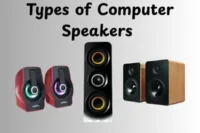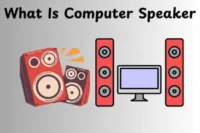Advantages and Disadvantages of Webcam: Complete Guide
Published: 13 Oct 2025
Did you know that over 80% of laptops today come with built-in webcams? Webcams have become essential tools for video calls, online learning, live streaming, and remote work. Understanding their advantages and disadvantages of webcam can help you make the most of this powerful device.To explore more, check out the different types of webcam and see which one best fits your needs.
Advantages of Webcams
Webcams have become essential tools for staying connected in today’s digital world. They make video calls, online learning, and content creation much easier and more interactive. Here are the main benefits of webcam:
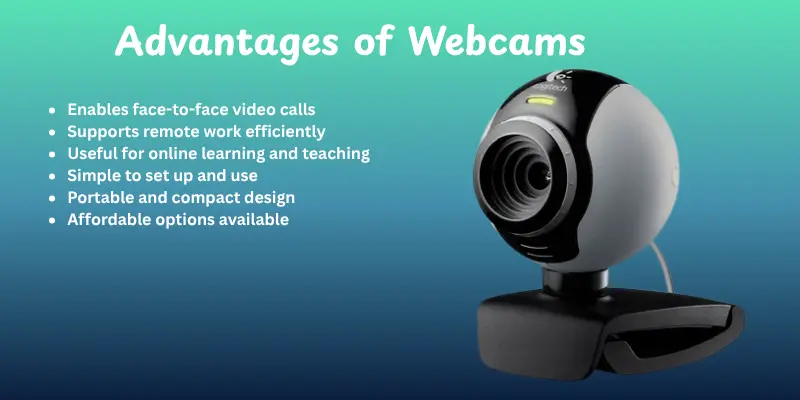
- Enables face-to-face video calls
- Supports remote work efficiently
- Useful for online learning and teaching
- Simple to set up and use
- Portable and compact design
- Affordable options available
- Enhances communication in online meetings
- Allows recording of videos
- Ideal for live streaming and gaming
- Supports home and office security monitoring
Enables face-to-face video calls
Webcams allow you to see and talk to people in real time, even if they are far away. This makes conversations more personal than just voice calls or emails. You can notice facial expressions and gestures, which improves understanding. Video calls are great for friends, family, or business meetings. They help people feel connected, no matter the distance.
Supports remote work efficiently
Webcams are essential for people working from home or remote locations. They let employees attend virtual meetings and communicate with colleagues easily. Managers can see team members and provide better guidance. Collaboration becomes smoother because everyone can share ideas visually. This makes remote work more productive and organized.
Useful for online learning and teaching
Webcams help students and teachers connect in online classrooms. Teachers can explain lessons while students watch and ask questions. It’s easier to stay engaged compared to audio-only learning. Webcams also allow teachers to demonstrate practical tasks or experiments visually. Students feel more involved and motivated.
Simple to set up and use
Most webcams are plug-and-play, meaning you just connect them to your computer and start using them. Built-in webcams in laptops need no extra installation. Even external webcams are easy to attach via USB. They usually come with simple software for adjusting settings. This makes them user-friendly for beginners.
Portable and compact design
Webcams are small and easy to carry anywhere. You can move them between laptops, desktops, or take them on trips. Their lightweight design doesn’t take up much space on your desk. Portable webcams are ideal for frequent travelers or remote workers. They offer convenience without compromising functionality.
Affordable options available
Many webcams are budget-friendly while offering good quality video. You don’t need to spend a lot to get a clear picture. Affordable webcams still provide features like autofocus and built-in microphones. This makes them accessible to students, professionals, and hobbyists. You can find a webcam that fits your needs without breaking the bank.
Enhances communication in online meetings
Webcams improve clarity during virtual meetings because participants can see each other. Visual cues like facial expressions and gestures help convey ideas better. They reduce misunderstandings that may happen in voice-only calls. Teams can build stronger connections and trust. Overall, webcams make online communication more effective.
Allows recording of videos
Webcams let you record videos for tutorials, presentations, or personal projects. You can save these videos for future use or share them online. Recording with a webcam is simple and doesn’t require complex equipment. Many webcams have features like high-definition recording. This makes creating content easier and professional-looking.
Ideal for live streaming and gaming
Webcams are widely used by gamers and content creators to stream live videos. They let viewers see the streamer’s reactions and expressions in real time. This makes streams more engaging and interactive. Many webcams offer features like high resolution and frame rates for smoother video. Streamers can build better connections with their audience.
Supports home and office security monitoring
Webcams can be used to keep an eye on your home or office when you are away. They allow live video feeds to your computer or smartphone. Some webcams have motion detection alerts for extra security. This helps prevent theft or monitor activities remotely. They offer peace of mind knowing you can always check your space.
Disadvantages of Webcams
Webcams are useful tools, but they also have some drawbacks. Understanding these limitations can help you use them more effectively and avoid potential issues. Here are the main drawbacks of a webcam:
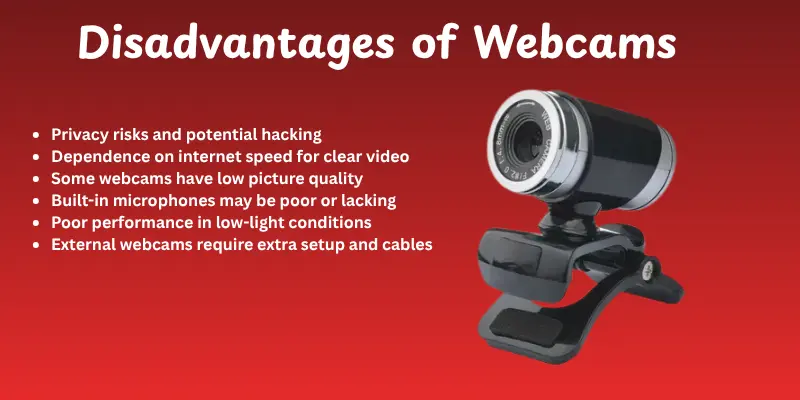
- Privacy risks and potential hacking
- Dependence on internet speed for clear video
- Some webcams have low picture quality
- Built-in microphones may be poor or lacking
- Poor performance in low-light conditions
- External webcams require extra setup and cables
- High-quality webcams can be expensive
- Can slow down devices during use
- May stop working due to driver or software issues
- Long use can raise security and privacy concerns
Privacy risks and potential hacking
Webcams can be accessed by hackers if your device isn’t secure. This can lead to unauthorized people watching or recording you. Using covers or security software helps reduce this risk. Always keep your webcam software updated. Being cautious online protects your privacy.
Dependence on internet speed for clear video
Webcams need a stable internet connection for smooth video. Slow internet can cause lagging, freezing, or poor image quality. Video calls may become frustrating if the connection is weak. High-speed internet ensures clear and uninterrupted video. This is important for meetings and online classes.
Some webcams have low picture quality
Not all webcams produce sharp images or videos. Low-quality webcams can make your video look blurry or pixelated. This can affect communication, especially in professional settings. Choosing HD or higher resolution webcams improves clarity. Better webcams show your face and surroundings clearly.
Built-in microphones may be poor or lacking
Many built-in webcams have microphones that don’t capture sound well. This can make your voice unclear or distorted during calls. Background noise can also be a problem. Using an external microphone can solve this issue. Clear audio improves communication significantly.
Poor performance in low-light conditions
Some webcams struggle in dim lighting. Your video may appear dark or grainy. Good webcams have low-light correction features to fix this. Proper lighting in your room can also help. Clear visibility is important for meetings and streaming.
External webcams require extra setup and cables
External webcams need to be connected and positioned properly. This can take time and effort to adjust. Some setups require long cables that may get in the way. Built-in webcams avoid this problem. Simple setups save time and hassle.
High-quality webcams can be expensive
Webcams with HD, 4K, or advanced features cost more. Not everyone can afford high-end models. However, investing in a good webcam improves video quality. Cheaper options may lack clarity or features. Choose based on your needs and budget.
Can slow down devices during use
Using a webcam, especially high-quality ones, can use your computer’s resources. This may make your device slower or cause other applications to lag. Closing unnecessary apps can help. High-performance computers handle webcams better. This ensures smooth operation during calls or streaming.
May stop working due to driver or software issues
Webcams rely on drivers or software to function properly. Outdated or incompatible software can make them stop working. Regular updates help prevent this. Reinstalling drivers can fix problems. Keeping software up-to-date ensures consistent performance.
Long use can raise security and privacy concerns
Keeping your webcam on for long periods can increase risks. Hackers may try to access your device. Even accidental exposure of sensitive information is possible. Using covers and turning off the webcam when not in use protects privacy. Awareness is key to safe usage.
Actionable Tips for Webcam Users
Using a webcam safely and effectively can improve your video calls and protect your privacy. Here are some practical tips to get the most out of your webcam:
- Cover the webcam when not in use.
- Use a strong internet connection for smooth calls.
- Choose good lighting for better video quality.
- Update webcam software and drivers regularly.
- Invest in an external webcam if high quality matters.
- Secure webcams with passwords or firewalls.
Conclusion
So guys, in this article, we have covered Advantages and Disadvantages of Webcam in detail. Personally, I recommend investing in an HD or Full HD webcam with a good built-in microphone to ensure smooth video calls and clear audio. Explore different options today and pick the one that fits your needs for better online meetings and streaming experiences.
FAQs
Webcams allow video calls, online classes, and meetings from anywhere. They make communication more personal and interactive.
Yes, webcams can cause privacy concerns and may sometimes have technical issues like poor video quality or lag.
Using a webcam can slow down older computers or use extra bandwidth, especially during video streaming or recording.
Webcams enable remote work, online learning, and presentations. They let teachers, students, and teams collaborate visually in real-time.
Cover your webcam when not in use and use security software to prevent unauthorized access. Always update your software for better protection.

- Be Respectful
- Stay Relevant
- Stay Positive
- True Feedback
- Encourage Discussion
- Avoid Spamming
- No Fake News
- Don't Copy-Paste
- No Personal Attacks

- Be Respectful
- Stay Relevant
- Stay Positive
- True Feedback
- Encourage Discussion
- Avoid Spamming
- No Fake News
- Don't Copy-Paste
- No Personal Attacks


